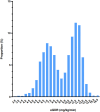U-shaped relationship of estimated glucose disposal rate with cardiovascular disease risk in cardiovascular-kidney-metabolic syndrome stages 0-3: a population-based prospective study
- PMID: 40069902
- PMCID: PMC11895221
- DOI: 10.1186/s13098-025-01659-y
U-shaped relationship of estimated glucose disposal rate with cardiovascular disease risk in cardiovascular-kidney-metabolic syndrome stages 0-3: a population-based prospective study
Abstract
Background: Cardiovascular-Kidney-Metabolic (CKM) syndrome is characterized by the interrelatedness of chronic kidney disease (CKD), cardiovascular disease (CVD), and metabolic disorders. The relationship between estimated glucose disposal rate (eGDR) and CVD risk in CKM syndrome remains unclear.
Methods: We analyzed data from 7,849 participants aged ≥ 45 years in the China Health and Retirement Longitudinal Study (CHARLS). The eGDR was calculated using waist circumference, hypertension, and HbA1c. Cox regression and restricted cubic spline (RCS) regression analyses examined the association between eGDR and CVD (stroke or cardiac events).
Results: During a mean follow-up of 8.29 ± 1.67 years, among 7,849 participants (mean age 62.4 ± 8.7 years; 52.82% male), 1,946 CVD events occurred, including 1,504 cardiac events and 663 strokes. CKM stages 0-3 comprised 492 (6.27%), 1,404 (17.89%), 5,462 (69.59%), and 491 (6.26%) of participants, respectively. A U-shaped relationship between eGDR and CVD risk was identified (turning point: 11.82 mg/kg/min). Below this turning point, each unit increase in eGDR decreased CVD risk by 12% (HR: 0.88, 95% CI: 0.86-0.90, P < 0.0001); above it, each unit increase raised the risk by 19% (HR: 1.19, 95% CI: 1.04-1.37, P = 0.0135).
Conclusion: Our findings reveal a U-shaped relationship between eGDR and CVD risk in CKM syndrome stages 0-3. A higher or lower eGDR was associated with an increased CVD risk.
Keywords: Cardiovascular disease; Cardiovascular-kidney-metabolic syndrome; China health and retirement longitudinal study; Estimated glucose disposal rate.
© 2025. The Author(s).
Conflict of interest statement
Declarations. Ethics approval and consent to participate: The study involving human participants was approved by the Peking University Institutional Review Board (IRB00001052-11015) and complied with the Declaration of Helsinki guidelines. Each participant gave written informed consent. Consent for publication: Not applicable. Competing interests: The authors declare no competing interests.
Figures




References
-
- Ndumele CE, Rangaswami J, Chow SL, Neeland IJ, Tuttle KR, Khan SS, et al. Cardiovascular-Kidney-Metabolic health: A presidential advisory from the American heart association. Circulation. 2023;148:1606–35. - PubMed
-
- Ndumele CE, Neeland IJ, Tuttle KR, Chow SL, Mathew RO, Khan SS, et al. A synopsis of the evidence for the science and clinical management of Cardiovascular-Kidney-Metabolic (CKM) syndrome: A scientific statement from the American heart association. Circulation. 2023;148:1636–64. - PubMed
-
- Virani SS, Alonso A, Benjamin EJ, Bittencourt MS, Callaway CW, Carson AP, et al. Heart disease and stroke Statistics-2020 update: A report from the American heart association. Circulation. 2020;141:e139–596. - PubMed
Grants and funding
- No. SZSM202211016/Sanming Project of Medicine in Shenzhen
- No. SZGSP006/Shenzhen Fund for Guangdong Provincial High-level Clinical Key Specialties
- Grant No.20223357008, No.2023xgyj3357003/Shenzhen Second People's Hospital Clinical Research Fund of Guangdong Province High-level Hospital Construction Project
LinkOut - more resources
Full Text Sources
Miscellaneous

